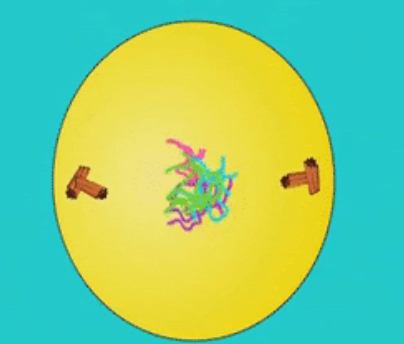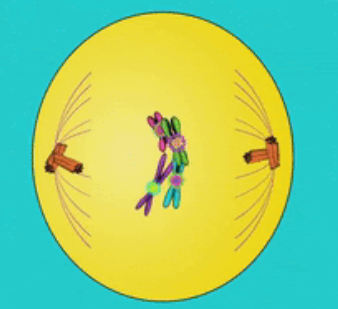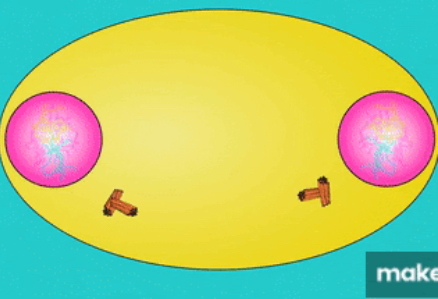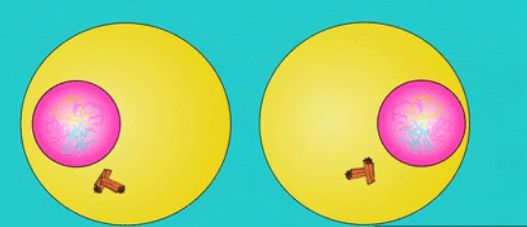Cell Division
1/81
Earn XP
Description and Tags
Name | Mastery | Learn | Test | Matching | Spaced |
|---|
No study sessions yet.
82 Terms
Stages of the cell cycle
Interphase (G1, S, G2) Mitosis (PMAT), Cytokinesis
Stages of interphase
G1, S, G2
what happens during G1 of interphase
proteins made and organelles duplicated
what happens during S-phase of interphase
DNA replication
what happens during G2 of interphase
Cell growth until it becomes large enough for division, synthesis of special proteins for mitosis
Name the 3 checkpoints in cell cycle
G1 checkpoint, G2 checkpoint, Metaphase checkpoint
what does the G1 checkpoint check for
DNA damage
What happens if the cell doesn’t meet requirements of G1 checkpoint
Cell enters resting state called G0
What does the G2 checkpoint check for
Cell has replicated DNA without error and has grown large enough to divide
What does metaphase checkpoint check for
That all chromosomes are attached to spindles and are aligned
What happens during the prophase of mitosis
chromatin fibres condense to form chromosomes
nuclear envelope breaks down
centrioles halve and move to poles
centrioles form spindle threads
What happens during the metaphase of mitosis
chromosomes move to central region of spindle
chromosomes attach to spindle thread by centromere
What happens during the anaphase of mitosis
spindle fibres shorten and pull sister chromatids apart towards poles
What happens during the telophase of mitosis
chromatids reach opposite poles, the uncoil to become long and thin again
spindle breaks down and dissapears
nuclear envelope forms around each set of genetic material
What happens during cytokinesis
Cell splits into 2, creating 2 daughter cells that are genetically identical to parent cell and one another

Prophase

Metaphase

Anaphase

Telophase

Cytokinesis
What is the significance of meiosis?
Gamete cells only need one chromosome from each pair during sexual reproduction
Are gametes haploid or diploid cells?
Haploid
What is meant by homologous pair of chromosomes
Have the same genes at the same locations
What is the difference between mitosis and meiosis 1?
Mitosis: sister chromatids are pulled apart, so end up with one chromosome from each pair in either new cell
Meiosis 1: homologous chromosomes are separated
What type of cells are created after meiosis I?
Haploid cells
What type of cells are created after meiosis II?
Haploid cells
What is crossing over?
Non-sister chromatids exchange alleles
What stage of meiosis does crossing over occur in?
Prophase
What two processes ensure genetic variation during meiosis?
Independent assortment, crossing over
What is independent assortment?
Random alignment of homologous pairs along the equator of the spindle
What is a bivalent?
When homologous chromosomes pair up
Compare anaphase I and II in meiosis
Anaphase I homologous pairs are pulled apart whereas anaphase II sister chromatids are pulled apart
What is a chromosome?
A thread-like structure containing nucleic acids that carries genetic information as genes
What is the point at which crossing over occurs called?
Chiasma
What is a chromosome made up of in meiosis I?
2 sister chromatids joined together by a centromere
How are chromosomes arranged in meiosis I?
Side by side, in homologous pairs (called bivalents)
How are homologous pairs of chromosomes pulled apart in meiosis I?
During anaphase I, microtubules pull whole chromosomes to opposite ends
Why is there not an interphase between meiosis I and II?
The DNA is not replicated
Erythrocyte function
Transport oxygen around the body
Erythrocyte adaptations
Biconcave shape to increase SA:V ratio, cytoplasm contains lots of haemoglobin, no nucleus, flexible to squeeze through narrow capillaries
Neutrophil function
Destroy pathogens by phagocytosis and secretion of enzymes
Neutrophil adaptation
Multi-lobed nucleus to get to site of infections, lots of lysosomes that contain enzymes to digest invading cells
Sperm cell function
Reproduction - to fuse with egg, initiate the development of an embryo and pass on fathers genes
Sperm cell adaptations
Haploid nucleus, acrosome in head contains digestive enzymes that can break down outer layer of egg cell, mid-piece packed with mitochondria to release energy for tail movement
Root hair cell function
Absorption of water and mineral ions from soil
Root hair cell adaptations
Root hair to increase SA so more uptake of water, thinner walls so water can move through easily, mitochondria for active transport of mineral ions
Ciliated epithelium function
Moving substances across the surface of a tissue
Ciliated epithelium adaptations
Cilia beat in a coordinated way to shift material along surface of tissue, goblet cells secrete mucus which helps to trap dirt/dust/microorganisms
Squamous epithelium function
Provide a surface covering or outer layer
Squamous epithelium adaptations
A single layer of flattened cells on a basement membrane, forming a thin cross section, shortening the diffusion pathway, permeable
Palisade cell function
Carry out photosynthesis to produce glucose and oxygen
Palisade cell adaptation
Large number of chloroplasts to maximise the absorption of light, tall and thin allowing light to penetrate deeper
Guard cell function
Control the opening of stomata to regulate water loss and gas exchange
Guard cell adaptation
Inner cell walls thicker/outer cell walls thinner to allow cell to bend when turgid, cytoplasm has high density of chloroplasts
Xylem tissue function
Transport tissue for water and dissolved ions
Xylem tissue adaptations
No top and bottom walls between cells to form continuous hollow tubes, cells are dead (free of organelles or cytoplasm) to allow free movement of water, outer walls thickened with lignin for support
Phloem tissue function
Transport of dissolved sugars and amino acids
Phloem tissue adaptations
Made of living cells supported by companion cells, cells are joined end to end and contain holes in the end cell walls which forms tubes, few sub cellular structures
Muscle tissue function
Contraction for movement
Muscle tissue adaptation
Layers of protein filaments which can slide over each other causing muscle contraction, high density of mitochondria
Cartilage function
To provide support
Cartilage adaptations
Strong and flexible tissue
What is a stem cell?
A cell that can divide by mitosis an unlimited number of times
What is potency?
The ability of cells to differentiate into more specialised cell types
Totipotent stem cells
Stem cells that can differentiate into any cell type found in an embryo, as well as extra-embryonic cells (cells that make up the placenta)
Pluripotent embryonic stem cells
Embryonic stem cells that can differentiate into any cell type found in an embryo but are not able to differentiate into extra-embryonic cells
Multipotent adult stem cells
Stem cells that can differentiate into a limited range of cell types
Adult stem cells function
Produce new cells for growth, cell replacement and tissue repair
Stem cell therapy
The introduction of adult stem cells into damaged tissue to treat diseases and injuries
What potency are stem cells found in bone marrow?
Multipotent (can only differentiate into erythrocytes, monocytes, neutrophils and lymphocytes)
What is a meristem?
Any undifferentiated tissue in a plant that has the ability to give rise to new cells
What is the cambium?
Tissue between xylem and phloem from which stem cells that form them originate
Which part of the cambium differentiates into xylem, and which into phloem cells?
Inner edge into xylem, outer edge into phloem
What happens to cambium cells that differentiate into xylem cells?
They lose their cytoplasm, deposit lignin in their cell walls and lose their end cell walls
What happens to cambium cells that differentiate into phloem cells?
They lose some of their cytoplasm and organelles and develop sieve plates (located at ends of cells)
What determines whether xylem or phloem tissue is produced from cambium?
The balance of different hormones
How many days after fertilisation are embryonic stem cells totipotent?
Up to 4 days
How many days after fertilisation do embryonic stem cells become pluripotent?
Day 5
Where are embryos used for research often sourced from?
The waste of embryos from in vitro fertilisation treatment
What are 3 examples of how stem cells can provide treatment for diseases/injuries?
Heart disease (when muscle tissue is damaged), Type 1 diabetes (patients have to inject insulin), treatment of burns
What is the main objection to using stem cells?
Religious objections - people belief life begins at conception and so destruction of embryos is murder
Why is the use of adult stem cells less controversial that embryonic stem cells?
The donor is able to give permission